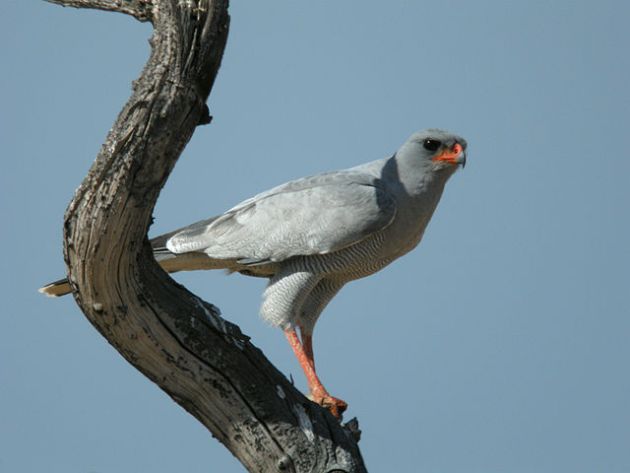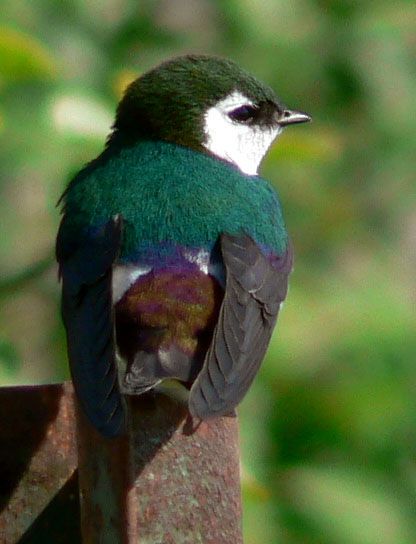
It’s no secret that I am a big fan of our more elaborate and storied bird names. Besides timberdoodles and whiskey jacks, I also have a soft sport for bird names that are official but still lovely or funny or charming or strange – the Flappet Lark, for instance, which sounds Seussian, and the the Dark Chanting Goshawk, which sounds more like it belongs in one of Jim Henson’s feature-length films. And, of course, the Smew.
That said, there’s a lot of bird names that are at first blush more prosaic, but still deeply satisfying. The Solitary Sandpiper is aptly summed up in those two words. The Wood Duck, while it deserves many lines of poetry in its own right, is named with a folksy straightforwardness that seems appropriate to its place in the American forest and the American literature. The Olivaceous Warbler, the Ivory Gull, and the Cinnamon Teal are all named simply for their color, but the names are nevertheless evocative.
So why doesn’t the name Violet-Green Swallow work for me? It’s certainly accurate. The iridescent sheen on the backs of these beautiful birds does in fact flash, according to the light, in the colors of majesty and of nature, which seems appropriate. Yet somehow it lacks poetry. Maybe it’s the awkward hyphen in the middle, or the fact that the name feels out of step with the names of other swallows, which are mostly named for their preferred nest-sites (of course, Cliff Swallow is already taken, which is perhaps why the Violet-Green was not named according to the standard idiom. Off the top of my head, I would prefer to call this bird the Splendid Swallow (it is!,) the Shining Swallow, or even the Lofty Swallow, which gets us at least back into the vicinity of its nest.
Are there any bird names that you irrationally dislike, or just don’t think are good enough for the bird in question?
Feature image by Noël Lee; Dark Chanting Goshawk by Frank Vasson; back view of Violet-green Swallow by Walter Siegmund















I hate the trend of adding descriptors to monotypic genera with unique names. Why Black-capped Donocabius? There aren’t other doncabiuses to distinguish it from. same with Broad-billed Sapayoa. Just call it a Sapayoa and be done with it.
Swallow-tailed Bee-eater is an awkward name to my ears. The general idea is nice, but the name’s length and two hyphens are just bad. Mind you, the German name of the bird, with an identical meaning, is even worse:
Schwalbenschwanzbienenfresser.
Oh yeah: Splendid Swallow is a clear winner. If the AOU’s bird name committee isn’t already looking for a new chair woman, they surely should do so now.
Most birds described by color are really boring. Especially those incorporating shades of brown and gray. And most especially because these names are completely generic. Take ‘Gray-breasted’ for example. There are fifteen (15) species that are Gray-breasted somethingorothers. Gray-breasted Francolin. Gray-breasted Partridge. Gray-breasted Crake. Gray-breasted Seedsnipe. Gray-breasted Sabrewing. Gray-breasted Mountain-Toucan. Gray-breasted Woodpecker. Gray-breasted Parakeet. Gray-breasted Flycatcher. Gray-breasted Martin. Gray-breasted Wood-Wren. Gray-breasted Prinia. Gray-breasted Parrotbill. Gray-breasted Babbler. Gray-breasted Spiderhunter. And that’s just the beginning: eleven Brown-backed birds, thirteen Olivaceous birds, ten Buff-breasted birds. Surely all of these birds could be better described by some characteristic other than their most-boring plumage detail?
People complain about birds being named after geographical locations or ‘old dead white men’, but naming birds after colors that can easily be used to describe mud is tragic.
Clay-Colored Sparrow!
My 10-year-old daughter and I have a long-running project to rename the bird species. The only one that’s really stuck with us so far is “Zebra Warbler” for Black and White Warbler.
Duncan – I imagine that at the time it was named they thought they might find another Sapayoa (but how did they know that one wouldn’t have an even broader bill?) Should definitely be changed now, though.
Jochen – Ah, the German. Truly, a versatile language, but not the most evocative.
If I were a parakeet and I ended up being the one stuck with Gray-breasted Parakeet, I’d be pretty mad.
English names seem to be off a lot when naming South Afircan birds (Afrikaans-speaking people seem more observant, naming birds after sounds or behavior). Three-banded plover (two bands), black-collared barbet (the red face doesn’t strike you at all, does it?), black-throated attle eye (two hypens and the striking white throat of the male). Redemption comes in the name of a beautiful bird: the gorgeous bush shrike.